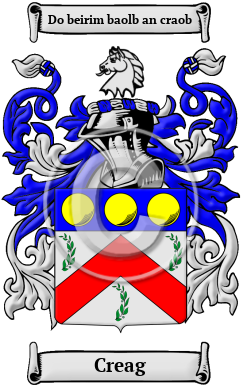| ![Show Contents]() Creag History, Family Crest & Coats of Arms Creag History, Family Crest & Coats of Arms
Etymology of CreagWhat does the name Creag mean? The surname is one of the many Irish surnames rooted in Gaelic language native to Ireland. The original Gaelic form of the name Creag is Craobhach, derived from the word "craobh," which means "branch." 1 Early Origins of the Creag familyThe surname Creag was first found in County Clare (Irish: An Clár) located on the west coast of Ireland in the province of Munster, where this ancient Irish family was descended from King Niall of "the Nine Hostages," the great General King, who in turn was descended from the Heremon line of Irish Kings. The Creaghs were one of the celebrated septs and leading gentry of the County Clare. They were a branch of the O'Neills of County Clare and tradition has it that they carried green branches with them into battle against the Norsemen at Limerick. Their name is derived from the Irish surname Craobhach, which is the adjective formed from the noun "craob," a branch. Other names are derived from this source as well such as Cray, the anglicized form of O Craoibhe meaning "descendant of Craobhach." Early History of the Creag familyThis web page shows only a small excerpt of our Creag research. Another 192 words (14 lines of text) covering the years 1500, 1505, 1514, 1518, 1520, 1523, 1525, 1541, 1567, 1585, 1676, 1689, 1692, 1693, 1705, 1707, 1848 and 1923 are included under the topic Early Creag History in all our PDF Extended History products and printed products wherever possible. Creag Spelling VariationsJust like the English language, the Gaelic language of Ireland was not standardized in the Middle Ages. Therefore, one's name was often recorded under several different spellings during the life of its bearer. Spelling variations revealed in the search for the origins of the Creag family name include Creagh, Crear, Creag, Creavagh, Cray and others. Early Notables of the Creag family- Richard Creagh (1525?-1585), born in Limerick, an Irish Catholic Archbishop of Armagh who died in the Tower of London. Called also Crvagh, Crewe, and in Irish O'Mulchreibe, he was born about 1525, bei...
- His nephew Peter Creagh, was Bishop of Cork and Cloyne from 1676 to 1693. The following were High Sheriffs of Limerick City: Richard Fitz-Nicholas Creagh in 1500; Nicholas Creagh in 1505; Christopher...
- Sir Michael Creagh was a seventeenth century Irish politician and soldier. He served as Lord Mayor of Dublin and was member of parliament for Dublin City in the Patriot Parliament in 1689
- Peter Creagh (d. 1707), was a Catholic prelate, probably a relative of Sir Michael Creagh. On 4 May 1676 he was nominated by the propaganda to the united bishoprics of Cork and Cloyne, and on 9 March...
| Creag migration to the United States | + |
Ireland became inhospitable for many native Irish families in the 19th centuries. Poverty, lack of opportunities, high rents, and discrimination forced thousands to leave the island for North America. The largest exodus of Irish settlers occurred with the Great Potato Famine of the late 1840s. For these immigrants the journey to British North America and the United States was long and dangerous and many did not live to see the shores of those new lands. Those who did make it were essential to the development of what would become two of the wealthiest and most powerful nations of the world. These Irish immigrants were not only important for peopling the new settlements and cities, they also provided the manpower needed for the many industrial and agricultural projects so essential to these growing nations. Immigration and passenger lists have documented the arrival of various people bearing the name Creag to North America:
Creag Settlers in United States in the 18th Century- Isabella Creag, who settled in Pennsylvania in 1772
| Creag migration to New Zealand | + |
Emigration to New Zealand followed in the footsteps of the European explorers, such as Captain Cook (1769-70): first came sealers, whalers, missionaries, and traders. By 1838, the British New Zealand Company had begun buying land from the Maori tribes, and selling it to settlers, and, after the Treaty of Waitangi in 1840, many British families set out on the arduous six month journey from Britain to Aotearoa to start a new life. Early immigrants include: Creag Settlers in New Zealand in the 19th Century- Mr. Creag, British settler travelling from London aboard the ship "Mandarin" arriving in Wellington, New Zealand on 21st May 1841 2
The motto was originally a war cry or slogan. Mottoes first began to be shown with arms in the 14th and 15th centuries, but were not in general use until the 17th century. Thus the oldest coats of arms generally do not include a motto. Mottoes seldom form part of the grant of arms: Under most heraldic authorities, a motto is an optional component of the coat of arms, and can be added to or changed at will; many families have chosen not to display a motto.
Motto: Do beirim baolb an craob
- MacLysaght, Edward, Supplement to Irish Families. Baltimore: Genealogical Book Company, 1964. Print.
- New Zealand Yesteryears Passenger Lists 1800 to 1900 (Retrieved 17th October 2018). Retrieved from http://www.yesteryears.co.nz/shipping/passlist.html
 |

